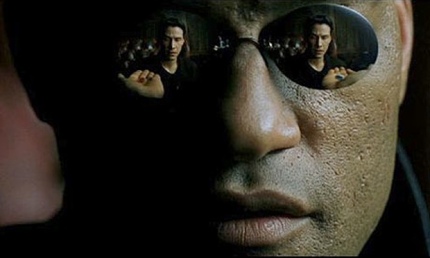The Matrix creates (at the time) the refreshingly innovative idea of not only an alternate reality, but also questions what makes ‘reality’ real. It brings a world full of cohesive, and at the time, brand new technology to the table. Throughout the film, The Matrix raises many questions, but gives little answers. From the beginning, the audiences is given little context, and less background about our protagonists. Introductions are made, but characterization is far from being given. Most of the dialogue in the beginning of the story centers on Neo being told of this faceless prophet. Neo is given hints at reality, but is never given any real explanations before he makes his life-altering decision. Slowly but surely, bits and pieces of reality are revealed to us, creating a general picture of the real world and the Matrix. The clearest distinction made is the distinction between reality, a post-apocalyptic world where artificial intelligence has enslaved humanity, and the Matrix, the artificial reality that the enslaved mind has been born believing in. With the creation of these two worlds, the more Neo discovers about the state of the world and himself, the more the audience is left wondering about the future and how they will change in relation to each other.

One of the major elements of the film that contributes to The Matrix’s momentum and intrigue is technology. At that time, the internet had just gained worldwide usage, though it was still a relatively new concept. Many people were still getting used to the idea of the ‘world wide web’ and software technology. The Matrix took this relatively new concept and expanded it to new proportions. Not only is the internet and intelligent technology present, but it dominates society. These ideas challenged everything we knew to be true, and created a need to pursue this technology driven society. Within the computer-generated world, characters are able to ‘download’ new skills into their virtual selves, and transport back into reality by picking up a phonecall. Within their reality, the rebels are able to hack into the computer mainframe, fly a war hovercraft, and use an electromagnetic pulse device to fight off the machines. These new technologies help fuel our need for answers for questions within the film, and for our curiosities regarding the future.
Another element adding to the mystique is the overall aesthetic of the characters. In the Matrix, the rebels are dressed in sleek all black skin-tight clothing distinguishing them from the attire of the people still trapped in the virtual world. They don dark, (Morpheus is the only one who wears reflective glasses without temples) almost sporty sunglasses, hiding their eyes as well as their emotions. The sunglasses are not present when they return to reality, where their true selves and emotions reside. While their attire is dark and polished, it draws much attention. They are both subtle and striking at the same time, drawing the audience’s attention and creating a desire to access their concealed emotion.
Some of the biggest questions raised revolve around Neo’s assumption (or rejection) of the role of ‘The One’, leader of the rebellion and savior of mankind. Morpheus hints at importance of Neo’s presence within their group early on, but for most of his time spent in the real world, he doesn’t believe Morpheus’s prophecy. He only fully realizes the extent of Morpheus’s belief when the oracle tells him of the choice he has to make, as well as the consequences of his decision. Questions are consistently being raised—Who is Morpheus really? Will we get a more in-depth look at this AI regime? Where is Zion, and how much of mankind remains? What does survival without earth’s resources look like? Finally, the huge question—will Neo end the rule of AI and liberate mankind? The film does a remarkable job of hinting at these questions/potential problems, and skillfully evades answering them. This system of lingering curiousity and doubt creates a slow thirst for resolutions—a thirst that only a sequel can quench.
















